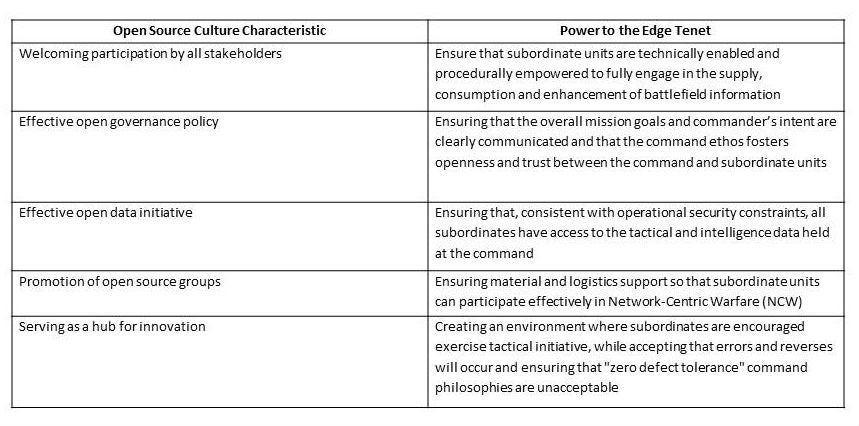Open source software offers the promise of a revolutionary transformation in defense, intelligence, law enforcement, and government technology at a cost and pace that satisfies the competing requirements of shrinking resources and constantly accelerating global operations. While this technological transformation is emphasized by engineers and developers within industry and the acquisition community, it is often perceived as tangential to those with an operational focus.
This apparent dissonance between the acquisitions and operational communities is caused by the broad nature of the open source phenomenon: Open source refers as much to a cultural perspective as it does to a technology model. However, the gulf separating the two sides isn’t as wide as it may appear. For the acquisitions community, open source technology enables the rapid insertion of new and improved capabilities. For the operators, open source culture enables the achievement of a doctrine and force structure for self-synchronizing operations. The cultural and technological synergy of open source is the catalyst for, as David Alberts and Richard Hayes put it, pushing "power to the edge."
Open source culture
One of the best expositions of open source culture is Jason Hibbets' The foundation for an open source city. In addition to being a compelling call to arms for open source advocates, the book offers a pragmatic exposition of the characteristics necessary for an organization to reap the benefits of open source culture. Open source, as Hibbets points out, encompasses more than the selection of a software licensing scheme. Open source is about empowering both creators and users to determine the most effective solutions to a problem and at the same time, empowering them to add experiential value to those solutions derived from their own knowledge and experience.
The characteristics of an 'open source city' are neatly summarized in five bullets:
- Fostering a culture of citizen participation
- Having an effective open government policy
- Having an effective open data initiative
- Promoting open source groups and conferences
- Being a hub for innovation and open source business.
It’s worth a brief look at each of these.
Citizen—and for our purposes, that can be read as 'user'—participation is critical to the rapid development of innovative solutions. Broad citizen participation allows issues and challenges facing a political entity to be placed before its constituency. More importantly, it allows for solution concepts to be drawn from the constituency—a much larger pool than government. The contemporary buzzword for obtaining ideas by casting challenges before a mass of people (especially from an online community) is 'crowdsourcing.' It’s really a much older concept. In The Cathedral and the Bazaar, open source evangelist Eric S. Raymond called it 'Linus’ Law,' in honor of the originator of Linux, an open source operating system, Linus Torvalds. Linus’ Law says: "Given enough eyeballs, all bugs are shallow," applying the principles of broad enfranchisement and participation to problem solving.
Open government policies are designed to improve transparency (and, concomitantly, trust), access to public information, and coordination between government (and other public sector entities) non-profit, the private sector, and the citizenry. They do so by emphasizing distributed review, inclusiveness and broad and diverse participation. Such policies are often tangibly expressed as publicly accessible web portals with open data, web, and mobile applications for visualizing and using the data and links to stakeholder organizations.
Open data initiatives are about making data both publicly available and useful. Making raw data sets accessible doesn’t help the vast majority of users. True open data initiatives provide mechanisms by which users can consume the available data. These may include visualization tools, search engines and web applications that enable users to derive benefit from the data.
Open source culture is grassroots in nature. In order to thrive it requires an environment in which stakeholder communities are encouraged and supported. Support means a number of things, including providing physical space in which to conduct activities and meetings, an environment that encourages a continual influx of new ideas and concepts, using official channels to disseminate information about and of relevance to the open source communities both internally and externally and, of course, financial support. The nature of this support is important; it should be enabling rather than prescriptive if the broad participation that empowers open source is to be effected.
The last characteristic, that of being a hub for innovation, is really the result of the other four. When a political entity enables open source with the encouragement of broad participation, enactment of governance policies, open data and material support, many groups with a common vision, but a diversity of approaches to realization, are brought together. The result is that only broad guidance is necessary to create the desired effects.
Power to the edge
Power to the edge is a command and control philosophy initially articulated in the early 21st century by the US Department of Defense Command and Control Research Program (CCRP). Command and control (C2) is, in US doctrinal terms, an organization’s ability to exercise authority and direction over subordinate components to achieve mission objectives. Command and control is achieved through the interplay of personnel, equipment, communications, facilities and procedures that enable a commander to plan, coordinate and control forces during operational activities.
Power to the edge philosophy emphasizes a decentralized form of command and control where the commander’s role shifts from one of providing prescriptive oversight (i.e., a goal, an operational solution and direction as to how to achieve that solution) one of providing general guidance and enabling support. The concept is not new; indeed, the German Army has emphasized what it called Auftragstaktik, or mission-type tactics, since the early 19th century. Auftragstaktik as a doctrine features individual initiative, independent decisionmaking and encouraging subordinate leaders to reach tactical decisions on their own accord in furtherance of a general command intent. The commander’s primary roles are to provide an overall vision of the objective end state and to support the force, giving virtual autonomy to the subordinate commanders in achieving her intent.
The key difference between Auftragstaktik as practiced by the German Army in two World Wars and Power to the Edge as envisioned by the CCRP is the addition of shared situational awareness, enabled and supported by robust networking, in both superior-subordinate and peer-to-peer relationships. Shared situational awareness between peer organizations engenders clear and consistent understanding of the commander’s intent, the timely exchange of relevant and high-quality information, a demand for competent participation at all levels and trust in and between the information being exchanged, subordinates, superiors, peers and technology. The result is that robustly networked organizations are able to self-synchronize, dramatically reducing both the need for command intervention to cope with the vagaries of the battlespace and the time required for the force to make sense of and respond to new operational stimuli.
For Power to the Edge/self-synchronization to work, the subordinate organizations must be technically enabled and procedurally empowered to fully engage in the supply, consumption and enhancement of battlefield information. At the same time, the commander must create an environment where all members of the community are aware of the overall mission goals, the intent is clearly communicated and where openness and trust between the command and subordinate units is fostered. Part of this environment is ensuring that, within relevant operational security constraints, all subordinates have on demand access to the tactical and intelligence data held at the command.
Additionally, the commander needs to ensure that subordinate units have the necessary material and logistics support (i.e., equipment, training, etc.) to participate effectively in Network-Centric Warfare (NCW), and to nurture a shared mindset that encourages subordinates to exercise initiative and find creative solutions without adverse impact for imperfect decisions. The last requirement is critical. Prudent risk-taking is an element of initiative, creativity and innovation. Power to the Edge demands that commanders encourage their subordinates to exercise tactical initiative, while recognizing that errors and reverses will occur. The sum of successes derived from the exercise of battlespace initiative, the theory states, will overcome the occasional setbacks. A 'zero defect tolerance' command philosophy discourages initiative and stifles innovation. In the open source and Agile communities, this is called 'failing fast,' and is a necessary and encouraged facet of the development life cycle.
A rose by any other name
Even a cursory familiarity with command and control philosophy shows a striking correlation between Power to the Edge and the tenets of open source culture. It’s possible, however, to go a step further and make a strong case that open source culture is synonymous with Power to the Edge, which is rapidly becoming the dominant battlefield doctrine of the 21st century. The table below relates characteristics of an organization that has embraced open source culture with corresponding tenets of Power to the Edge doctrine:

Conclusion
Open source is more than a licensing scheme for software or a business model. It is an organizational culture and a management philosophy that leads to efficient and effective project execution, often at a significant savings in time and resources. With widespread acceptance of Power to the Edge doctrine, open source is no longer a countercultural rebellion against the inefficiencies of large organizations. Instead, it has matured into the dominant management philosophy of one of the largest and most complex enterprises on the planet. We can only hope to see industry and government follow suit.
Originally posted on The Intelligent Triad. Reposted under Creative Commons.







4 Comments